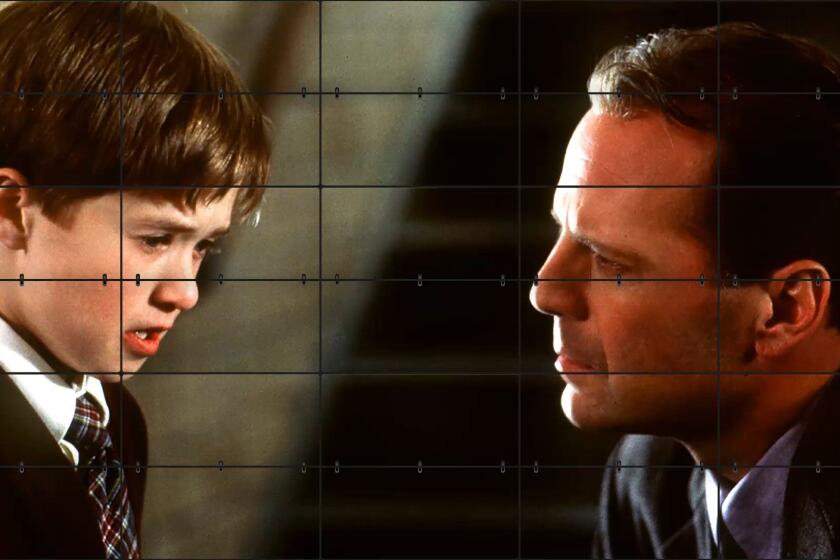‘Race movies,’ lost and found, shed light on an era
They are big-screen films that only some of America -- its segregated citizens -- saw in the 1930s, ‘40s and early ‘50s.
There’s the story of Daisy Mae Walker, a fresh-faced girl who leaves tiny Prairieville, Texas, to find fame as a singer in big (bad) New York City. Another film features two down-and-out rascals who arrive in South Dallas with nothing more than a quarter between them but enough smarts to con free room and board out of the family of an aspiring beauty pageant contestant, Honeydew Holiday. There is the reluctant draftee who opposes World War II but ends up a patriotic hero.
Once thought lost, the “race movies,” as they were known, which were shown mostly in the segregated movie houses of the Old South, have been reproduced as a three-DVD box set and in recent months distributed to 1,000 poor school districts and African American museums in Texas.
There are tales about entrepreneurs, lawyers, novelists, preachers, musicians, cabdrivers and farmers. And, yes, the movies include gangsters, swindlers, bumblers, compulsive gamblers and plain mean folks.
In plot, they’re not much different from other Hollywood films of the pre- and post-World War II eras, but white society was never meant to see them.
Some were produced by African Americans, all were written and directed by blacks, and, with very few exceptions, they featured only black actors.
This was the black response to white Hollywood during a time of legal segregation: produced on shoestring budgets, shot in one take and starring polished actors -- Clarence Muse and Spencer Williams, for instance, who went on to Hollywood careers -- alongside complete amateurs.
Seven feature-length films and seven shorts and newsreels were put on the three DVDs through a digitization project overseen by Southern Methodist University. The set, which includes scholarly introductions to each movie or short, is also available for sale to libraries and the public by SMU’s Hamon Arts Library, home of the G. William Jones Film and Video Collection.
For these films -- called the Tyler, Texas, Black Film Collection -- it represents a new life, once again. The first resuscitation came in 1983, when thousands of 35-millimeter film canisters were discovered in a dusty corner of an old warehouse in Tyler, 85 miles east of Dallas. One summer day, the warehouse manager telephoned Jones, then the director of the Southwest Film/Video Archives at SMU.
“Would your archives be interested in taking a look at what appear to be some old films which have been sitting in one of our warehouses for a long time?” Jones recalled being asked, in his 1991 book, “Black Cinema Treasures: Lost and Found.”
“Nobody here wants them, they’re taking up a lot of space and we’re getting ready to dispose of them unless you want them.”
Jones did. What he found in the stacks of octagonal steel film cans were reels of highly flammable pre-1950 nitrate stock. Much of the film was in various stages of decomposition, but Jones salvaged more than 100 feature and short films. Most were prints of standard Hollywood movies from the 1930s and ‘40s. But among them were 22 black-audience films, including a movie by Oscar Micheaux, the dean of black filmmakers, and some titles believed to have been lost forever.
“It’s a miracle that any of this film survived,” said Tinsley Silcox, director of the Hamon Arts Library, which owns the Tyler Collection and the university’s film and video archive, renamed in 1995 for Jones. Jones taught film and video at SMU for 27 years and died in 1993. He also co-directed and wrote a documentary in the early 1990s called “That’s Black Entertainment,” featuring the Tyler films and other examples of the approximately 200 to 400 race films made in the first half of the 21st century.
Within a year after the warehouse discovery, Jones obtained a grant to transfer the volatile stock to 35-millimeter safety film. Since then, the Tyler Collection has been shown intermittently at black film festivals and in selected libraries and museums across the country. With advances in technology and a state grant of $65,000 to digitize some of the restored collection, many of the films are now available for wide distribution -- a goal that Jones did not live to see realized.
“He felt there was a moral imperative to preserve and enhance these films,” Silcox said. “They really are a rare glimpse of black life [from the 1930s to the 1950s] devoid of Hollywood stereotypes.”
And that, said one scholar, makes these films informative too.
“They show what people were wearing, how they moved, how they talked,” said Jacqueline Stewart, an associate professor of English and a member of the Committee on Cinema and Media Studies at the University of Chicago. “It teaches us about black style at that time, and it’s not just an imitation from Hollywood.”
More to Read
Only good movies
Get the Indie Focus newsletter, Mark Olsen's weekly guide to the world of cinema.
You may occasionally receive promotional content from the Los Angeles Times.










